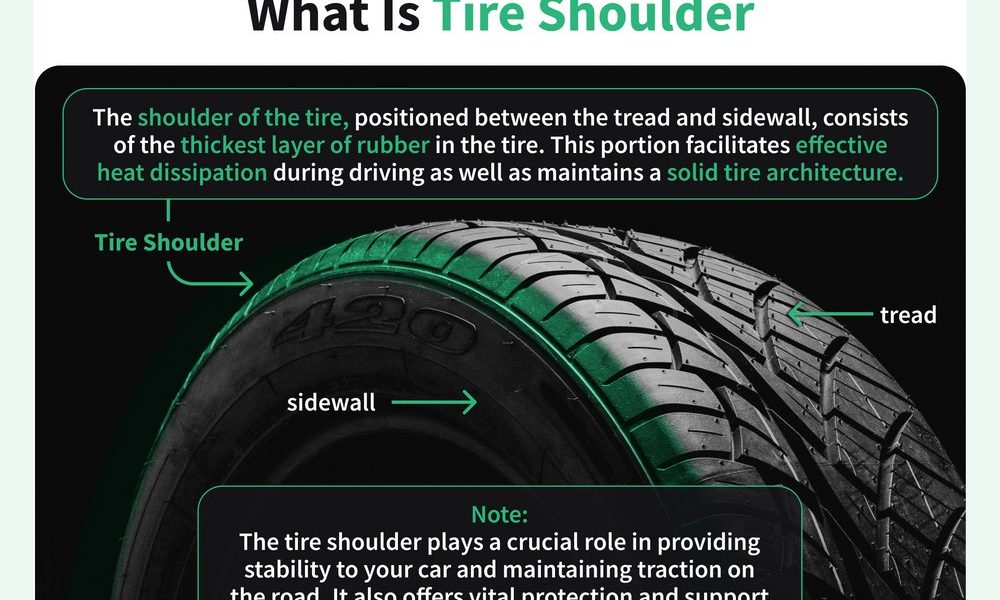The shoulder of a tire is the crucial outer edge that connects the tread to the sidewall. This often overlooked part plays a significant role in handling and stability. It provides essential support during cornering and maneuvering, making it a vital component of your vehicle’s performance. Understanding the shoulder of a tire can help you appreciate its importance in ensuring a safe and smooth ride. Let’s delve deeper into what exactly the shoulder of a tire is and why it matters.
Exploring the Shoulder of a Tire: A Comprehensive Guide
Understanding the Basics
Have you ever wondered what makes a tire so important for your vehicle? Well, one crucial part of a tire that plays a significant role in its performance is the shoulder. The shoulder of a tire refers to the outer edges on both sides of the tire’s tread. It connects the tread to the sidewall and plays a vital role in providing stability, handling, and overall safety while driving.
The Function of the Shoulder
The shoulder of a tire acts as a transition area between the tread and the sidewall. Its design is not just for aesthetics but serves practical purposes that contribute to the tire’s overall functionality. The shoulder helps the tire maintain its shape, especially during cornering and other maneuvers, by providing additional support to the tread area.
Enhancing Handling and Stability
One of the primary functions of the shoulder is to enhance the tire’s handling and stability. When you take a sharp turn or navigate through a curve, the shoulder of the tire comes into play by providing additional grip and traction. The design of the shoulder helps in distributing the forces evenly, allowing for better control of the vehicle.
Supporting Weight and Load
Another crucial function of the shoulder is to support the weight of the vehicle and the load it carries. The shoulder area of the tire absorbs a significant amount of pressure and impact, especially when driving over bumps or uneven surfaces. This support is essential for maintaining the integrity of the tire and ensuring a smooth and comfortable ride.
Types of Tire Shoulders
Tire shoulders come in different designs and configurations, each serving specific purposes based on the type of vehicle and terrain it is intended for. Let’s explore some common types of tire shoulders:
1. Rounded Shoulders
Rounded shoulders are typically found on tires designed for high-performance vehicles. The smooth curvature of the shoulder allows for better handling and cornering capabilities, making them ideal for sports cars and performance-oriented driving.
2. Square Shoulders
Square shoulders have a more angular design compared to rounded shoulders. They are commonly seen on tires meant for trucks and SUVs. The sharp edges of square shoulders provide stability and traction, making them suitable for off-road driving and heavy loads.
3. Tapered Shoulders
Tapered shoulders have a gradual slope from the tread to the sidewall, offering a balance between handling and stability. They are often found on all-season tires that cater to a wide range of driving conditions, providing a versatile option for everyday use.
Maintaining the Shoulder of Your Tires
To ensure optimal performance and longevity of your tires, it’s essential to pay attention to the condition of the shoulder. Here are some tips for maintaining the shoulder of your tires:
1. Regular Inspections
Inspect the shoulders of your tires regularly for signs of wear, cracks, or bulges. Any abnormalities in the shoulder area could indicate a problem that needs to be addressed promptly.
2. Proper Inflation
Maintaining the correct tire pressure is crucial for preserving the integrity of the shoulders. Underinflated or overinflated tires can cause excessive wear on the shoulders, leading to reduced performance and safety risks.
3. Rotating Tires
Rotate your tires regularly to ensure even wear across the shoulders. Uneven wear patterns can affect the handling and stability of your vehicle, emphasizing the importance of proper tire maintenance.
In conclusion, the shoulder of a tire plays a crucial role in the overall performance and safety of your vehicle. Understanding its functions and characteristics can help you make informed decisions when choosing tires for your car. By maintaining the shoulder area and following proper tire care practices, you can ensure a smooth and enjoyable driving experience while staying safe on the road. Remember, the shoulder may just be one part of the tire, but it is a vital component that deserves attention and care.
Tire shoulder EMERGENCY repair with reXpair Premium toolkit
Frequently Asked Questions
What does the term “shoulder of a tire” refer to?
The shoulder of a tire is the area located between the tread and the sidewall. It is the part of the tire where the tread transitions into the sidewall, forming the outer edge of the tire.
Why is the shoulder of a tire important?
The shoulder of a tire plays a crucial role in providing stability and handling characteristics. It is responsible for maintaining contact with the road during cornering and ensuring proper distribution of forces across the tire’s surface.
How does the design of the shoulder impact tire performance?
The design of the shoulder, including its shape and tread pattern, directly affects the tire’s grip, traction, and cornering ability. A well-designed shoulder can enhance performance by improving handling and steering response.
What are some common issues that can occur with the shoulder of a tire?
Common issues with the shoulder of a tire include uneven wear, shoulder cracking, and damage from road hazards. These problems can impact the overall performance and safety of the tire, highlighting the importance of regular inspections and maintenance.
How can proper maintenance of the shoulder area prolong a tire’s lifespan?
Maintaining proper tire pressure, rotating tires regularly, and ensuring proper alignment can help prevent premature wear on the shoulder area of a tire. By taking these preventive measures, drivers can extend the lifespan of their tires and optimize performance.
Final Thoughts
The shoulder of a tire refers to the curved area where the tread meets the sidewall. It plays a crucial role in providing stability and traction during cornering. The design of the shoulder impacts the tire’s handling and performance. Understanding what the shoulder of a tire is helps drivers appreciate its importance in overall tire function and safety. Make sure to monitor and maintain this vital part of your tires for optimal performance on the road.




